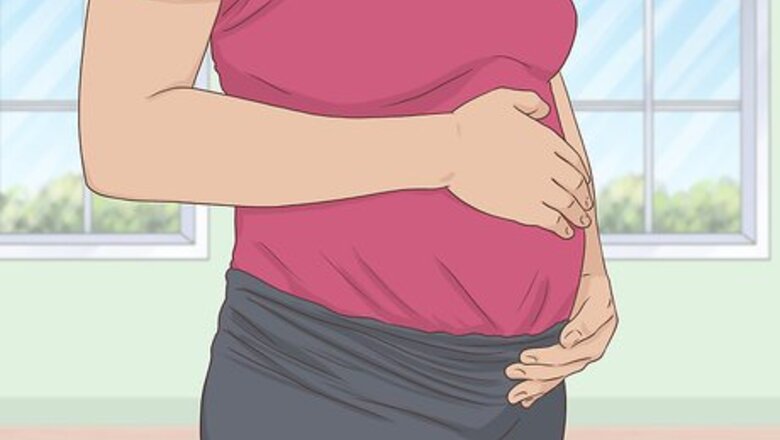
views
Finding the Right Maternity Pants Size

Wait until your belly starts to show to start buying maternity clothes. This usually starts to happen at about 12 to 16 weeks into pregnancy, but it might happen earlier or later for you. You may start looking for maternity clothes as early as 8 weeks or as late as 20 weeks depending on how your old clothes are fitting you. Keep in mind that your belly is more likely to start to show early if this is not your first pregnancy. You may be able to fit into your regular clothes for the first 3 to 4 months of your pregnancy, but as time goes on, your clothes will start to feel tighter around the waist. Don’t try to squeeze into clothes that are too tight! Wear looser fitting items in your closet until you are ready to buy maternity clothes.
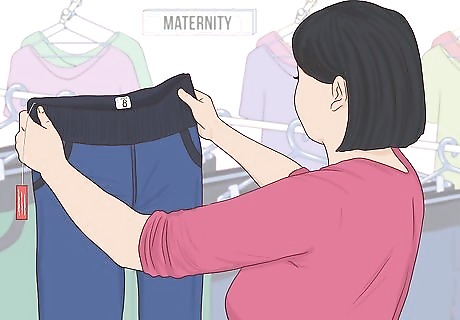
Find maternity pants in the size you wore before you were pregnant. Maternity pants use the same sizing system as regular pants, but they are made to accommodate a growing belly, so there’s usually no need to go up a size. Using the same size system as regular clothing simply makes it easier for you to find your size in maternity clothing. For example, if you wore a size 8 in most brands of blue jeans before you became pregnant, then you will most likely wear a size 8 in maternity jeans. You can go up or down a size as needed for comfort. For example, if a size 8 feels snug on you, then try a size 10.
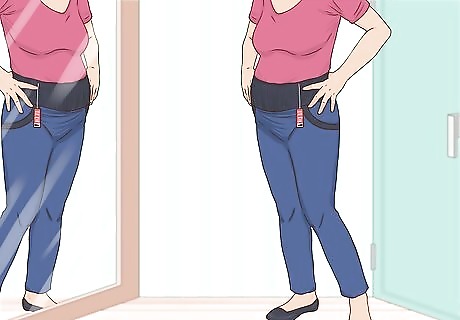
Try on the pants before you buy them to ensure that they fit. Maternity clothes fit different from brand to brand, and certain styles might feel more comfortable or look better on you. You may also find that certain items fit better during different points in your pregnancy. Try on maternity pants before you buy them to ensure that they fit and that you like the way they look and feel. If you are ordering pants online, make sure that you can return the pants if they do not fit. If you are early in your pregnancy, ask if the store has a strap on belly you can use to help you find pants that will fit you properly.Tip: Plan to buy 2 pairs of maternity pants along with other maternity wardrobe essentials, such as comfortable bras and underwear, loose-fitting tops, a skirt or dress, and comfortable shoes.

Choose pants that stretch and give you room to grow. Many styles of maternity pants have an elastic waistband that goes over or under your belly and that will conform to your belly as it grows. Ensure that the pants are made from a material that also has some stretch to it. If the pants do not have much give to them, then you might need to go up a size or opt for a different type of maternity pants. For example, if you try on a pair of maternity jeans at 26 weeks and the waistband feel like it is at its limit, then go up to the next size or choose a different brand.
Selecting a Style
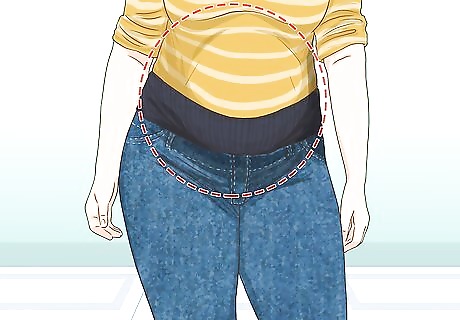
Choose maternity jeans with a waistband that feels comfortable on you. You can find maternity jeans that have a built-in belly band that goes over or under your bump, or you can choose maternity jeans that sit extra low so that they do not go over your belly at all. Select the style that feels most comfortable to you. Some common maternity jean waistbands include: Jersey basque (a built-in belly band that stretches as your belly grows) Under -the-bump (this may work best early in your pregnancy) Over-the-bump Drawstring Fly-front with adjustable straps Expanding-waist with elastic side panels
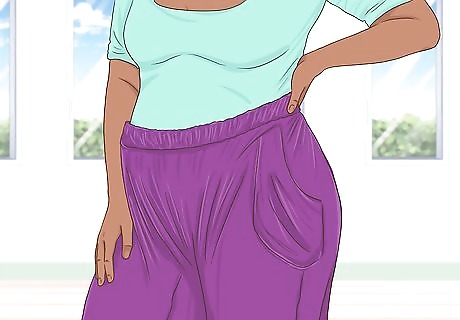
Go with pants that are appropriate for the season. Think about when you will be wearing the pants or jeans. How many months do you have until your due date, and what seasons will pass in that time? Depending on the season, you may need pants that are cool, warm, moisture-wicking, or lightweight. For example, if you will be wearing the pants through spring and summer, then you will most likely want lightweight, moisture-wicking pants made from a breathable material, such as cotton or linen. If you will be wearing the pants through the fall and winter, then you will want something warm and thick, such as denim, wool, or corduroy.

Opt for leggings or jeggings if you want something easy to move in. Consider the types of activities you plan to do in your pants. Leggings or jeggings (blue jean leggings) are a good choice if you want something that will move with you and that won’t feel restrictive. Even if you are not very active, leggings or jeggings are a comfortable choice and they also pair well with lots of different tops and dresses. Try getting a pair of black leggings or dark denim jeggings for something that will match almost anything in your closet. Look for moisture-wicking leggings or jeggings if you plan to exercise or be active in them.
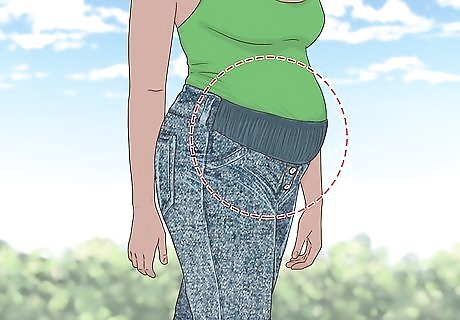
Try a pair of jeans if you’re going for a casual look. Maternity jeans are a stylish, comfortable option for maternity pants. You can dress them up with a nice blouse, or dress them down with a t-shirt. Find a pair that fits you comfortably through the hips, thighs, and legs as well as around your belly. Don’t shy away from trendy cuts, such as skinny jeans and bootcut jeans, while you are pregnant. You can wear any style of maternity jeans that make you feel good and that fit you comfortably.

Go with slacks if you want to look professional or dressy. It’s a good idea to invest in at least 1 pair of maternity dress slacks that you can wear with a nice blouse or sweater. This is a great option for special occasions or to wear to work. Opt for slacks that include a built-in belly band and that fit you well through the hips, thighs, and legs. Black, grey, and navy are all great options for maternity slacks. They will pair well with lots of different items in your closet.Tip: Keep in mind that you will likely need to continue wearing maternity pants for a few months after giving birth.
Wearing Non-Maternity Pants During Pregnancy
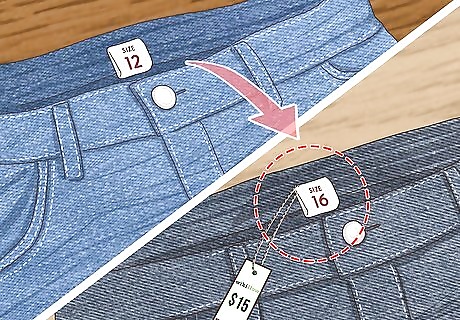
Select pants 1 to 2 sizes larger than your normal size if you don’t want to buy maternity pants. If you do not want to buy maternity pants right away or at all, you can also wear slightly larger regular clothing during your pregnancy. This should provide enough extra slack for the pants to fit around your belly and hips. For example, if you normally wear a size 12, then go with a size 14 or 16. If you normally wear a small, then go with a medium or large. Tip: Keep in mind that buying non-maternity clothes in a larger size may not be as flattering as maternity clothing.
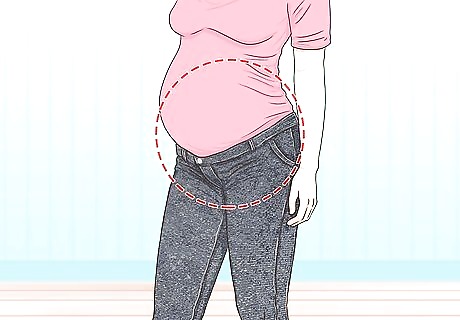
Look for low-rise pants if you want to avoid pulling pants over your belly. Jeans, slacks, and leggings that sit low on your hips will eliminate the need to find pants that are loose on your waist. Instead, you can opt for pants with a waistband that will stop below your belly. For example, you can opt for low-rider jeans, yoga pants with a fold-over waistband, or leggings that sit low on your hips.
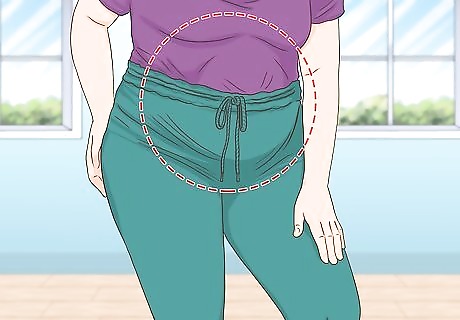
Opt for drawstring and elastic waistbands if you want something easy to adjust. Pants that have a drawstring closure or that have an elastic waistband with a lot of stretch are another good option. These will feel loose and comfortable around your belly and you can easily adjust them as your belly grows. For example, you could wear sweatpants with a drawstring tie when you are relaxing at home or running errands. For something dressier, wear a pair of black slacks with an elastic waistband.
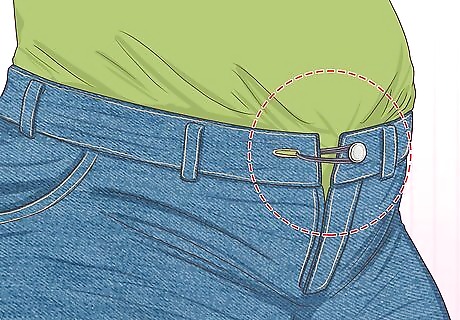
Use an elastic band if you want to extend the waistband of a pair of jeans. Put the jeans on and zip them as far as you can comfortably. Then, insert the end of an elastic hairband through the buttonhole on your jeans. Fold the hair band in half and then loop both ends of the hair band over the button to secure the waist. This works best early in your pregnancy when you just need a little extra slack to keep your jeans on. You can use this technique for other types of pants that have a button closure.
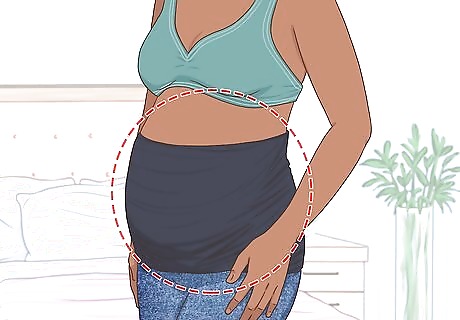
Wear a belly band over your pants if you cannot close them. You can purchase an accessory called a belly band to help make your regular pants last longer. Zip your pants as much as you are able, and then slide the belly band over the top portion of your pants to hide the opening. This works best when you can no longer zip up your pants more than halfway.



















Comments
0 comment